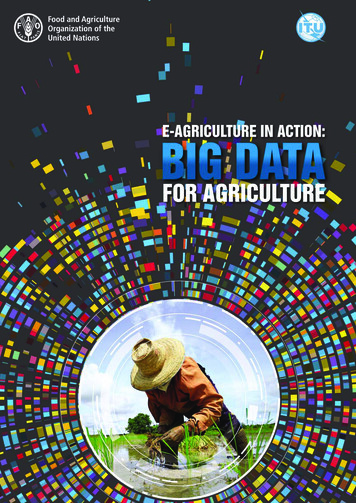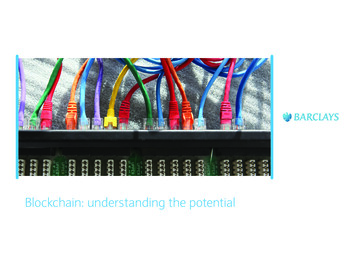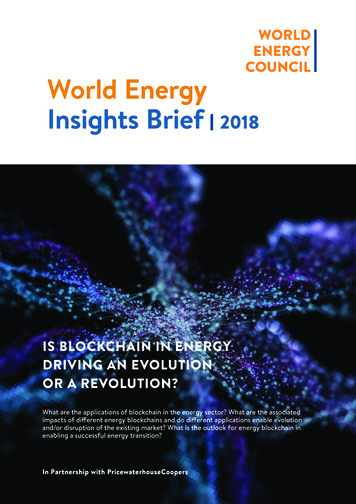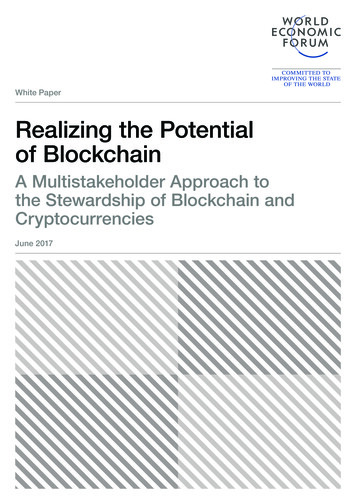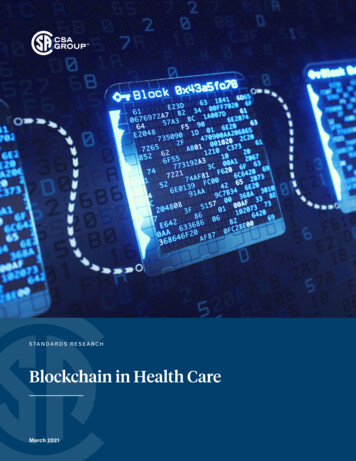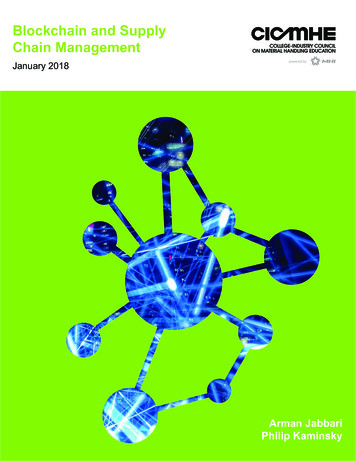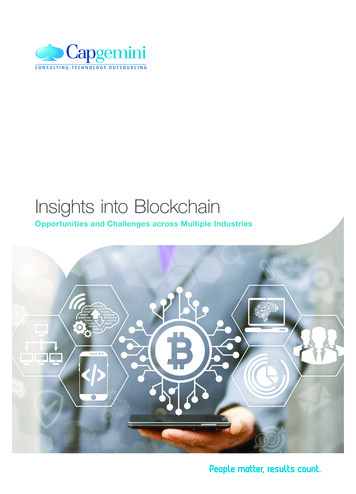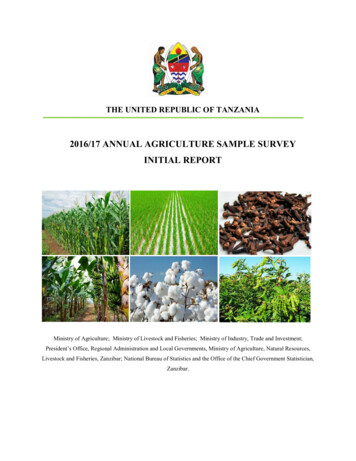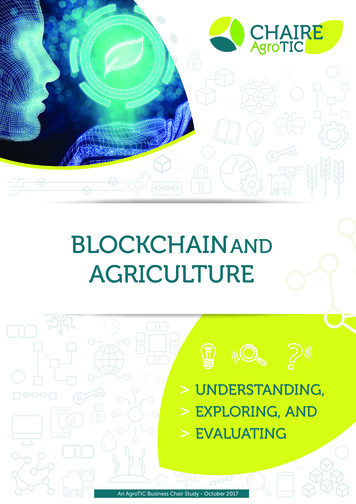
Transcription
BLOCKCHAIN ANDAGRICULTURE UNDERSTANDING, EXPLORING, AND EVALUATINGAn AgroTIC Business Chair Study - October 2017
TABLE OF CONTENTSIntroduction. 3PART I:Understanding. 41 What is a blockchain?. 42 How does it work?. 83 From blockchain to blockchains (distributed ledger technology - DLT).11Smart contracts: a major functional shift.11Private blockchains: a shift in governance.11The blockchain ecosystem: a shift in service development. 124 Why does blockchain arouse so much interest?. 14PART IIExploring its potential. 161 From promises to examples of uses. 162 Examples in all sectors.173 Examples in agriculture. 19PART IIIEvaluating.291 Is blockchain technology all it is chalked up to be?.302 Is blockchain technology 100% trustworthy?.323 Is blockchain technology mature?.334 Will legal uncertainty be a concern?.35Conclusion. 37ACKNOWLEDGEMENTSWe'd like to thank the people who took time to answer our questions: Emmanuel Delerm, Project Director, Carrefour, Paris Christine Hennebert, Researcher at CEA-LETI, Grenoble B runo Lauga, Project Manager, Information Systems and Methodology department, ARVALIS,Boigneville N icolas Pauvre, Project Manager, and Paul Bounaud, Senior Manager, wines, spirits andrestaurants, GS1 France, Paris Nicolas Philippe, Big Data, Simulation & Blockchain Manager, technology unit, CATIE, Bordeaux Cyrille Sauvignac, Lab Innovation Manager for the Aquitaine region, Atos, Bordeaux Florent Saucède, University lecturer, Montpellier SupAgro, MontpellierAn AgroTIC Business Chair Study - October 20172
INTRODUCTIONBlockchain: Not a week goes by without this term appearing in the press. It is a trend, to say the least!This technology, which allows the creation of a distributed and forgery-proof record, or ledger, oftransactions is even hailed as a "revolution", likely to be useful in many sectors. However, despite thissurge in interest, blockchain remains a hard-to-understand technology.In any case, this was the impression of members of the AgroTIC Digital Agriculture Business Chair,who were keen to know if and how this technology could affect the agricultural sector. The AgroTICChair decided to conduct its first feasibility study on the subject of blockchain.The problem with blockchain is that a string pulled to find out more information quickly becomesa whole ball! We felt it was important to start with the fundamentals, to understand the basis ofthe technology and what makes it so innovative. Our goal here is nevertheless humble: to offer anoverview of theory and practice so as to better understand the technology and new possibilitiescurrently under study. Knowing more will clarify future horizons, both for users and developers ofsolutions. Tests and feedback will enrich this overview and provide a comprehensive vision of whatthe technology has to offer.THIS DOCUMENT IS DIVIDED INTO 3 PARTS:"UNDERSTANDING"reviews the fundamentalprinciples of blockchainfrom a technical perspectiveand identifies in detail itsmain properties."EXPLORING ITSPOTENTIAL"presents several waysthe technology is usedand focuses on potentialapplications in theagriculture sector."EVALUATING"looks at issues surroundingthe use of blockchainto reveal any barriers orshortcomings and identifyfuture technologicalprospects.An AgroTIC Business Chair Study - October 20173
PART I:UnderstandingFURTHER READING:1 I What is a blockchain? La blockchain décryptée : les clés d'unerévolution - Blockchain France (1) Comprendre la blockchain livre blanc Uchange (2)A search for the meaning of 'blockchain' often turns up thefollowing type of definition: La blockchain pour les entreprises MEDEF (3) "A blockchain is a secure public ledger platform shared by allparties through the Internet or an alternative distributed network ofcomputers" (Pillington, 2015). (5) "A blockchain is an open and secure method of storing and distributinginformation which operates without a central server. By extension, ablockchain is a database containing a record of every transaction betweenusers from its creation onward. It is a secure, distributed database that is sharedby the different parties without an intermediary, allowing each user to verify thevalidity of the chain". (Blockchain France / Blockchain Partner). (6) Réalités industrielles - Blockchain etsmart contracts :des technologies de la confiance ?- Annales des Mines (4)These definitions are clear, but additional information is useful.A distinction should be made between "the" blockchain and "a" blockchain: (2) "the" blockchain refers to a type of technology (or more accurately an innovative combination ofpre-existing technology) developed by a certain Natoshi Sakamoto and revealed in 2008, based oncryptography, among other things. "a" specific blockchain refers to a given protocol and network that an individual or organisation canuse. Bitcoin is a blockchain. Ethereum is another.LET'S REVIEW THE TERMSIN THESE DEFINITIONSTO CLEARLY UNDERSTANDWHAT THE TECHNOLOGYENTAILS:LEDGERDISTRIBUTED,WITHOUT A CENTRALSERVERSECUREAn AgroTIC Business Chair Study - October 20174
I Blockchain: a "ledger" technology which stores arecord of transactionsLedger Arecord oftransactionsThe 'blocks' in blockchain are batches of transactions. In computing, atransaction is an indivisible series of operations to go from State A to StateB: a purchase, a payment, or to send a message, for example. A blockchain istherefore a database to which transactions, grouped together as blocks, are addedin chronological order. It is similar to a ledger, where each line is a transaction. A keyfeature of this ledger is that it is written in indelible ink: every page can be consulted,lines can be added, but existing data cannot be deleted or changed. Users on the peer-topeer network receive identical copies of this ledger.I Blockchain: a technology based on distributed architectureand governance A PEER-TO-PEER (P2P) NETWORK.Distributed computing is a computer system architecturein which resources are located in different places. Theseresources are not organised around a central server. Ablockchain is therefore a network of computers (witheach computer acting as both server and client) whichexchange data directly across the network withoutgoing through a central server (similarly to the peer-topeer tools used to share multimedia content, like eMule,for example). The blockchain eliminates the need for acentral authority. The devices making up the networkare called nodes. The ledger is replicated at the node level.CentralisedDecentralisedWHICH OPERATES BY DISTRIBUTED CONSENSUSIn a traditional, centralised system, central servers act as a trusted authority. They verify whetherconditions are met to enable transactions, and then carry them out. However, centralised computingimplies a high level of trust in the central unit and can be a source of risk (attacks are easier at a singlelocation), infrastructure costs, and longer processing times. These intermediaries do not exist in ablockchain system. The nodes in the network perform verification and carry out tasks. To do so they– a majority, in any event – must concur, even if they do not know or trust one another. Blockchainoperates according to a common set of rules based on consensus mechanisms (run by algorithms).This is a distributed consensus, the result of which is that trust is not limited to a single authority butspread over an entire network. Different consensus mechanisms exist. We will discuss them later.An AgroTIC Business Chair Study - October 20175
I Blockchain: a technology made secure by cryptographyThe vast blockchain "ledger" is accessible to all users. This means that the list oftransactions is visible to all. Cryptography, however, is used to:Secure make the chain unalterable by linking each transaction block to the precedingone use of hash functions. guarantee the signature of transactions the principle of authentication by publickey cryptographyLet's look at these two concepts:HASH FUNCTIONSHash functions, or hashes, are algorithms that generate a digital fingerprint from input data (an entiredocument, for example): just like a human fingerprint matches a single individual, a digital fingerprintidentifies a single, unique unit of data. The slightest change to the input data will yield a completelydifferent fingerprint.Example: Comparison of hashes (function SHA-256) for the word AgroTIC with and without an exclamation mark.AgroTIC b0254b27d054eaAgroTIC! 51bec55acdf622This hash function is one-directional. It is impossible to return to the original data from theobtained hash.These functions ensure that the ledger cannot be altered.Each block in the chain consists of a header and new transactions. The header of the block stores adigital fingerprint containing a "digest" of the transactions in the block (the root of the "hash tree" or"Merkle Tree"). Each block is linked to the preceding one via a hash derived from the header of theprevious block: that way, every block contains a print of part of the previous block, so that even theslightest change made to a transaction after its consignment results in the entire chain being changed.Since the chain is duplicated in multiple copies, any modification is noticeable. And given the numberof copies, and the principle of distributed consensus, it is difficult to pass any anomaly onto all thecopies in the chain. Each newly-added block secures the chain a little bit more. This is what makes ablockchain appear tamper-proof.Header of block 1Header of block 2Header of block 3Hash of headerof preceding blockHash of headerof preceding blockHash of headerof preceding blockVersion, Date, Difficulty,NonceVersion, Date, Difficulty,NonceVersion, Date,Difficulty, NonceRoot of transactiontreeRoot of transactiontreeRoot of transactiontreeTransaction of block 1Transaction of block 2Transaction of block 3Simplified blockchain diagram (for something like Bitcoin) (Source: www.ethereum-france.com)An AgroTIC Business Chair Study - October 20176
PUBLIC-KEY, OR ASYMMETRICAL CRYPTOGRAPHYThis cryptography method is used to ensure the confidentiality of a data transfer between 2 parties orensure the authenticity of a message signature without sharing a secret code between the 2 parties.The method involves 2 connected keys: one private, and one public. The private key is a strictlypersonal one that is not to be shared. The public key is shared with the entire network (the 'address' ofa party to which transactions can be sent is determined using the party's public key).Encrypted textNetworkEncrypted textThe sender encryptsusing a private keySender'sprivate keySender's publickeyVisible textVisible textComparisonThe receiver (or node)decrypts usingthe sender's public keyGeneral principle of signatureauthentication Source: inspiredby http://www.linux-france.org.In the case of blockchain, this mechanism is used to authenticate a signature.To initiate a transaction between Alice and Bob, Alice must use her private key to "digitally sign" hermessage (e.g. "I hereby send 200 monetary units to Bob"): To her open message she adds a signature that matches the "digital fingerprint" ofthe open message. This print is then encrypted using a private key.Nodes in the network are sure the message comes from Alice if they are able to decrypt itssignature using the public key. The transaction is authenticated if the parties are able to decrypt thedigital signature of Alice using her public key and establish that thisdecrypted signature and the fingerprint of the open message are identical.An AgroTIC Business Chair Study - October 20177
2 I How does it work?To understand how this actually works, take the example of the firstblockchain put into use at world level: Bitcoin.A1This transaction is sent to thenodes in the network.2Nodes, called "miners" in the case ofBitcoin, encode and verify the transaction.It is important to check whetherconcerned parties in the transaction haveauthorised it, and whether the transactionis feasible. For example, does the receiverhave sufficient funds?3If approved, the transaction is added to a block ofother pending transactions. Each miner prepares itsown block from a list of pending transactions (blocksare pre-defined in size and the number of transactionsin a block varies). In order to be added to the chain,the block itself must be verified and approved byconsensus: the miners must provide proof that theblock has, in fact, been checked (see box). This solvessyncing and logging problems by establishing priorityrules.456Sender/party A uses his private key toinitiate a transaction with receiver B,identified with a public key.When a block is approved, it istimestamped and each node adds it to itsown copy of the chain. (*)BThe transaction can reach its receiver andis visible to the entire network. For Bitcoin,the operation takes around ten minutes, thetime needed for the proof mechanism.An AgroTIC Business Chair Study - October 2017Created in 2009, Bitcoin is a digitalcurrency, or "cryptocurrency"for peer-to-peer payments (forpurchases of goods and services,but also now exchanged for 'real'currencies).Bitcoinoperatesaccording to an open protocol(open source code) which allowsusers to issue Bitcoins and managetransactions in a collective andautomatic manner thanks to theinteroperability of the software andservices involved. Bitcoin is both apayment intermediary and a storeof value limited to 21 million units('Bitcoin' is also the name of theunit) (7). The Bitcoin blockchaintracks every transaction carriedout since its creation. Like allcryptocurrency, Bitcoin has noreal underlying value: it is onlyvaluable on the internet and relieson a speculative mechanism.(*) Note: Sometimes, due to thetime it takes to synchronise nodes,two nodes transmit their versionof the block simultaneously. In thiscase, the chain can temporarily havetwo different branches. Each nodecontinues to operate according tothe block it received first, but keepsthe other pending. When the nextblock is added, the longest branchbecomes the valid one and the otheris discarded.8
PROOF OF WORK AND OTHER CONSENSUSMECHANISMSIn a decentralised system without a trustedthird party, and where, in theory, there isno trust between individuals, consensusmechanisms are essential. To worktogether, network users must abide byuniversally accepted rules, allowing as manyusers as possible to concur, and ensuringthat those who take part in decisions arelegitimate (and are not malicious).In the Bitcoin network, blocks are approvedusing a form of consensus called Proof-ofWork: evidence that effort has been madeto verify a transaction (8). This mechanismrequires such a level of computing power toapprove each block that it deters maliciousattacks and makes it nearly impossible tore-write the chronology of the chain.Since each miner prepares a block, it isnecessary to select which one will beadded to the chain. The following ruleapplies: the miner that solves a complexmath problem first is allowed to add hisblock. For example, parties could beasked to add (or concatenate) a randomvalue to the preceding header to obtain ahash below a certain threshold (the hashmust begin with a series of 0s for this towork, which requires several attempts).Problems get increasingly complex as theblockchain evolves, but the solution isalways easy to check. As a result, the blockis approved if more than 50% of the nodesapprove the result. Given the high level ofcomputing power required, this is handledby specialists. In exchange for this work,miners receive tokens (worth a fractionof the cryptocurrency), which act as anincentive to keep the network runningsmoothly. This is where the term "mining"originated, in reference to gold miners whoearned money from their work The Proof of Work mechanism wasthe first to be used in blockchains, butother consensus protocols are also nowcommon (see (9)). One option frequentlymentioned is "Proof-of-State", a protocolthat requires far less computing power andenergy, in which miners (called "minters")earn the right to approve, or sign, blocksby betting cryptocurrency units. The morethey have, the greater their chance of beingselected by the algorithms.It should be noted, however, that not allblockchains require these relatively complex mechanisms. We will see that certainchains are private, or managed by a limited number of parties. Where trust is lessof an issue, approval mechanisms are farmore simple and use little energy. Sometimes a block can be approved simply byX number of N nodes to be consideredvalid (e.g. a simple voting system). Or certain nodes can be deemed contractuallyresponsible for approving blocks.An AgroTIC Business Chair Study - October 20179
As seen above, blockchains have the followingcharacteristics:LOGGINGTransactions are added chronologically: they aretimestamped and inter-linked.UNALTERABILITY OF RECORDED DATAThe record is replicated multiple times and theslightest modification changes the entire chain.DISINTERMEDIATION ANDDECENTRALISATIONThe peer-to-peer nature of the network makes acentral server unnecessary.SECURITYThe distributed consensus nature of the systemmakes attacks more difficult. A digital signatureguarantees the origin of the transactions.TRANSPARENCYNodes contain the entire chain and can accesstransactions.Blockchains are first and foremost a technology which"ensures the sincerity and validity of any kind of transaction"(10): a "trust machine", in the words of The Economist (31Oct/6 Nov 2015).Summary: Blockchains make it possible to keep a secure and shared ledger of transactions. Theyare based on two major technologies: cryptography and peer-to-peer architecture, whichensure that data is highly secured and tamper-proof. They operate on the principle of collective governance based on a consensus mechanism,and have the potential to remove the need for intermediaries and a central authority. Because of the mechanisms involved, based on sharing and data transparency,blockchains can be seen as 'trust machines'.An AgroTIC Business Chair Study - October 201710
3 I From blockchain to blockchains(distributed ledger technology - DLT)As seen above, the blockchain is a shared and secure database.As such, it records (ledger) and exchanges data (such as payments). Other protocols have rapidlyappeared to meet new needs. These protocols have added new functions, as well as new ways to viewgovernance.Where once there was "the blockchain", now there are many. Original blockchain 'purists' refer tothe technology in general as: "Distributed Ledger Technologies" (DLT).S MART CONTRACTS:A MAJOR FUNCTIONAL SHIFTSmart contracts are stand-alone programs which automatically carry out the termsand conditions of a contract according to predetermined parameters, without theneed for human intervention once implemented (Blockchain France, 2015). Thecontract's terms and modalities are embedded in the blockchain and thereforecannot be altered.Once again, this is not a new concept. The term "smart contract" was used for thefirst time in 1993 by computer scientist Nick Szabo. The development of the Ethereumnetwork took the technology to another level by associating it with a cryptocurrency(Ether, in the case of Ethereum), allowing a completely automatic and secure exchange of assets.Smart contracts pave the way for new developments: in combination with connected objects, forexample, they can establish a secure link between virtual and physical spheres. A sensor can collectdata which, when sent, triggers a series of automatic transactions stipulated in a smart contract (e.g. apayment triggered when geolocation provides proof that a parcel has reached its destination).P RIVATE BLOCKCHAINS:A SHIFT IN GOVERNANCEPRIVATEPUBLICAs a completely open and transparent technology (e.g. Bitcoin), blockchains are very original.However, the concept quickly attracted criticism from those less eager to share or make decisionstogether. Less open blockchains were quick to appear.Three main kinds of blockchains exist. (11) Public, or "permissionless" blockchains:Anyone can approve transactions and take part in the consensus process.Anyone can send transactions for approval and integration in the blockchain if the transactions arevalid.Anyone can consult transactions.This type of blockchain is truly decentralised, which allows for lower infrastructure costs for anygiven party since these are shared across the entire network (no servers to maintain, for example). Acryptocurrency is closely linked, as a financial incentive, to ensure the network is well maintained. Thistype of blockchain is not easy to change because all parties must agree.Examples: Bitcoin, Ethereum, Litecoin, etc. Consortium blockchainsThe consensus process is handled by pre-selected nodes (similarly to a consortium of bankingestablishments that agrees to a set of common rules). Transactions are either open to all, restricted tonetwork participants, or only partially accessible.These blockchains are considered to be partially decentralised.An AgroTIC Business Chair Study - October 201711
Private, or "permissioned" blockchainsThese chains are owned by a given organisation which has complete control over permission to writeand consult. In practice, they are regulated, subverting the original idea behind Bitcoin. Purists refuseto call these types of chains blockchains. This type of chain does not rely on a cryptocurrency or onproof-of-work, or proof-of-stake mechanisms. They are still blockchains in that they are distributed andsecured by encrypted authentication.There are pros and cons to each type of chain, and some are better suited to certain contexts thanothers. For example, public blockchains work well for consumer-to-consumer (CtoC) applications,while private chains are better for business-to-business (BtoB) uses.Private blockchains are still often a means for companies to test the technology with less impact, buteventually it is likely that the different kinds of blockchains will co-exist and operate together. This isalready the case: sidechains can be used to create linkages between different blockchains.T HE BLOCKCHAIN ECOSYSTEM:A SHIFT IN SERVICE DEVELOPMENT A blockchain is built in layers, exactly like the internet:The "infrastructure" layer is the distributed "database", the actual chain of blocks, and the network inwhich it is replicated.This layer of infrastructure is topped by a "protocol" level: a set of rules followed by the blockchain,such as verification and transaction approval rules The "technological" layer is the intermediate layer offering services used to process blockchain dataand make it available to applications.The application layer is composed of applications which interact with users. At this level, the blockchainis transparent to the user. This is the "blockchain-as-a-service" level (Baas).Blockchainecosystem(Source: taken from a CATIE-organised "DA'telier" presentationby Charles Garnier, 23 May 2017) Colouredcoins &Open assets Logistics loT Hardware &StorageBASICLSBLOCKCHAIN PROTOCO Smart Contract Entreprise Platforms Culture Energy Oracles Server-less apps PredictionStates CrowdfundingT E CH N O LOGICAL LAYER Notary services E-identityAssociations Payment Data ationBLOCKCHAIN-AS-A-SERVICEPublicorganisationU SERAn AgroTIC Business Chair Study - October 201712
Depending on their needs, a company has several options for implementing blockchain technology(see (12), chart below), including the use of a development platform.APPROACHHOW IT IS DONEEXAMPLEComputer servicesWe do it for youMajor digital services firmsBlockchain firstYou work directly with blockchain toolsand servicesBitcoin, EthereumDevelopment platformsTools for IT professionalsBlockApps, Blockstream, Eris, EthCore,Hyperledger, TendermintVertical solutionsFor industryAxoni, Chain, Cleamatics, DAH,itBit, R3API and specific sub-layers"Do-it-yourself" building blocksBlockstack, Factom, open Assets, TierionSource: William Mougayar, 2016, www.coindesk.comIn the long-term, the ecosystem will likely be built around service providers that develop the technologicallayer on one hand, and companies that develop sector-specific applications on the other.Service providers, including majors like IBM and Microsoft, will need to successfully impose theirservice environments to allow companies to create, launch, operate and monitor blockchain-basedapplications. To this end, IBM is developing services based on Linux Foundation's HyperLedger.Microsoft is focusing on its Azure platform, and Orange on Chain.Companies developing sector-specific applications need to be the one to offer the "killer app", theone which will make the massive adoption of blockchain technology possible.Summary: There are not one, but many types of blockchains, each with different characteristics andfunctions. Smart contracts and self-executing computer code, add value to the simple principle ofa distributed database: they offer the possibility of connecting the physical and the virtual. Private blockchains exist now. They move away from the original philosophy of a systemmanaged entirely by its users. Blockchains already enrich a veritable ecosystem of participants and solutions.An AgroTIC Business Chair Study - October 201713
4 I Why do blockchains generate so much interest?BLOCKCHAINS ARE OFPARTICULAR INTERESTBECAUSE THEY ARE ATECHNOLOGY DESCRIBED ASBEING DISRUPTIVE.Blockchains – public blockchains in particular – have enormous potential to transformand imply paradigm shifts: They reinvent trust. By eliminating the need for a central authority, And because they are based ontransparency and distributed consensus, they change the way trust is granted (see "educational talk"by Claire Balva at TEDxLyon on this topic (13)).Until now, the common modus operandi has been to delegate trust to a third party: a banker, anotary, a certification body, or a state. However, such third parties are fallible, and may be subject tosecurity breaches. They can also arbitrarily decide to change the rules. Blockchains "re-invent trust"by distributing it: transactions are approved and carried out not only by one person or entity, but by awhole community. Instead of trusting an authority, trust is placed in a technology (and mathematics!). This allows risk to be pooled: once again, risk is not concentrated on an intermediary but sharedby all. Blockchains imply sharing tools, transparency, decentralisation, and establishing functions specificto a collaborative or sharing economy. Cryptocurrencies, which exist independently of states andbanks, are one form of this, but not the only one. Because they are based on a peer-to-peer network,blockchains open the door even further to "uberisation", the phenomenon of putting professionals andclients in direct contact. Blockchain makes it possible to sidestep this type of service platform. Partiestrade units of value of any kind securely: this is called "tokenisation", from the term "token", where atoken can be an asset, a production unit, or something immaterial like time, a voting right, a reputation,etc.(14)An AgroTIC Business Chair Study - October 201714
This new technology re-invents the power balance between parties and how they interact Inprivate or consortium-based blockchains, power sharing between parties that propose the technologyand partners who adopt it will probably have to be based on a subtle balance. "A joint form ofcoordination is needed, based on power without abuse and trust
Nov 06, 2015 · Understanding 1 I What is a blockchain? A search for the meaning of 'blockchain' often turns up the following type of definition: "A blockchain is a secure public ledger platform shared by all parties through the Internet or an alternative

